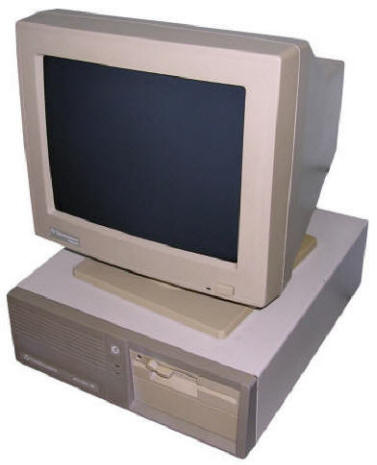Commodore PC20-III
Continuing the Commodore PC-compatibles line, after
different variations of PC-10 and 20, Commodore engineers came with
something smaller. PC-10-III and 20-III, released ca. 1988, were
re-designed Commodore PCs with smaller casing, more compact mainboard
and many peripherals built-in. CPU has been accelerated to maximum
9.54MHz, there was 640kB of RAM and most PC20 machines had some hard
disk - starting from 20MB. Hard disks were connected using a new
interface called XTA (XT Attachment) which was a predecessor of IDE.
It was also released under brand "Commodore Colt". Some modification was
also known as HD40 or "Select Edition" - this one had 40MB hard disk.
| Manufacturer | Commodore | |
| Origin | USA | |
| Year of unit | 1988? | |
| Year of introduction | 1988 | |
| Class | XT | |
| CPU | Intel 8088 | |
| Speed | 4.77MHz 7.16MHz (Double Mode) 9.54MHz (Turbo mode) |
|
| RAM | 640kB | |
| ROM | Commodore PC BIOS | |
| Graphics | CGA/Monochrome (Paradive PVC4) This unit: ATI Graphics Solution SR |
|
| Sound | PC Speaker | |
| System expansion bus | 8-bit ISA (3 slots) | |
| Floppy/removable media drives | 1x 360kB 5.25" floppy drive | |
| Hard disk: | 20MB WD XTA drive | |
|
Peripherals in collection: |
||
| Other boards:
|
ATI Graphics Solution SR graphics adapter | |
| Non-standard expansions: | ||
| Operating system(s): | MS-DOS |
My unit came to me in quite neglected condition - I had
to replace RTC battery and one chip which was corroded by leak. What is
unusual, it has an ATI Graphics Solution SR graphics adapter in ISA slot
(manufactured ca. 1988). This is strange as PC20 already has a Paradise
PVC4 CGA graphics chip. Both graphics adapters work perfectly when
separated, so I think that someone had compatibility problems with
Paradise. I left it there.
Another interesting part is a "PC10C OSC Tower" - a small PCB mounted
instead of quartz generator. It seems that Commodore fixed the clock
problems with triple-clock using this PCB.
| Contents: | Starting, usage | Jumper settings | Links |
Starting
It's a PC clone. It starts, displays BIOS POST where it checks e.g. RAM, then it tries to boot from floppy. If this doesn't work, it tries to boot from HDD. During initialization it is only important to keep the disk in its factory low-level format, as using MFM low level format tools on XTA disks usually ends with damaged hard drive.
This machine does not have a "Turbo" button. If you use
a normal XT keyboard, to set CPU frequency, you have to use SPEED.EXE
(see files in Zimmers.net files archive in Links section) program or
keyboard shortcuts:
- CTRL+ALT+S - Switches to "Standard" mode - 4.77MHz
- CTRL+ALT+T - Switches to "Turbo" mode - 7.16MHz
- CTRL+ALT+D - Switches to "Double" mode - 9.54MHz
DIP switch bank i located on the rear of computer. It
configures on-board graphics adapter. OFF (0) is when switch is up, ON
(1) when down. So:
0110 - CGA, 40-column mode
0101 - CGA, 80-column mode
0000 - Monochrome
http://www.zimmers.net/anonftp/pub/cbm-pc/ALLFILES.html -
Interestong files in Bo Zimmerman's site. Service manuals, diagnostic
manuals, disk images, ROM dumps...
http://gona.mactar.hu/Commodore/monitor/schematics/1404_Monitor_Service_Manual.pdf
- Commodore 1404 service manual
https://ancientelectronics.wordpress.com/2015/06/17/commodore-colt-commodore-pc10-iii-pc20-iii/
- Discovering Commodore Colt
http://www.classic-computers.org.nz/blog/2010-11-18-exploring-a-commodore-pc-10-III.htm
- Exploring PC10-III - similar unit





